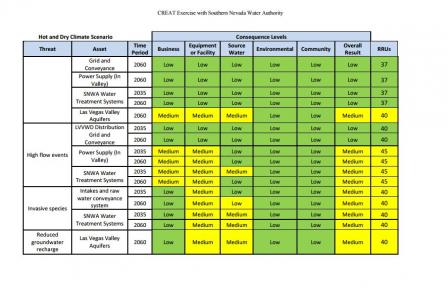Southern Nevada Water Authority Assesses Vulnerability To Climate Change
 Preliminary Table of Assessed Threats and Likelihood For Each Scenario and Time Period Climate Resilience Evaluation and Awareness Tool Exercise with Southern Nevada Water Authority.Southern Nevada Water Authority (SNWA) -- a cooperative of seven water and wastewater agencies -- serves more than two million residents in Nevada, including the city of Las Vegas. SNWA worked with the U.S. EPA’s Creating Resilient Water Utilities program to conduct a vulnerability assessment of the Las Vegas service area that considered climate impacts and vulnerabilities in two future scenarios (in 2035 and in 2060). Projected climate impacts included hotter and drier summers, drought conditions, and increased algal blooms.
Preliminary Table of Assessed Threats and Likelihood For Each Scenario and Time Period Climate Resilience Evaluation and Awareness Tool Exercise with Southern Nevada Water Authority.Southern Nevada Water Authority (SNWA) -- a cooperative of seven water and wastewater agencies -- serves more than two million residents in Nevada, including the city of Las Vegas. SNWA worked with the U.S. EPA’s Creating Resilient Water Utilities program to conduct a vulnerability assessment of the Las Vegas service area that considered climate impacts and vulnerabilities in two future scenarios (in 2035 and in 2060). Projected climate impacts included hotter and drier summers, drought conditions, and increased algal blooms.
This vulnerability assessment also helped identify more than 60 potential current and future actions to take in response to and prepare for climate change. SNWA followed up this initial analysis with a more in-depth assessments of water source availability under future climate change, population, and water demand projections. These assessments provide SNWA with a better understanding of its climate risks and potential vulnerabilities. The information also informs the water authority’s ultimate consideration, selection, and implementation of appropriate adaptation strategies. SNWA continues to anticipate, prepare, and plan for the future as a member of the Water Utility Climate Alliance; a consortium of 10 of the largest water utilities around the country actively engaged on climate change.
| How Did They Do It? | Applicable EPA Tools |
|---|---|
Identified projected climate risks and assessed utility vulnerability
|
EPA’s Climate Resilience Evaluation and Awareness Tool (CREAT) can help assess water utility vulnerability. |
Utilized asset/threat pairings to identify and select “adaptation packages” of applicable strategies
|
The Adaptation Strategies Guide can help formulate packages of appropriate adaptation strategies. To better understand how occurrences of harmful algal blooms can be affected by climate change, view the Harmful Algal Blooms & Climate Change Factsheet. |
Identified initial assessment limitations and the need to conduct further analysis before implementing adaptation strategies
|
Hydrologic and Water Quality System can provide a more in-depth modeling platform to estimate future climate impacts on water quality and pollutants. |
Similar Cases and More Information
For more case studies from Water Utility Climate Alliance Members, see the Tampa Bay Water case studies. For more information about ensuring available water supply in the future with climate change view the Anacortes, WA case study. For other cases working to ensure water quality under projected climate impacts view the Pennsylvania Natural Resources Adaptation Plan.

